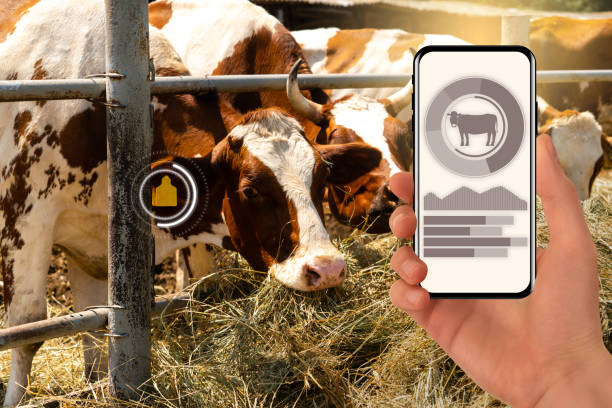
The Future of Livestock Farming: Smart Farming Gadgets for Cows and Buffaloes
Explore the cutting-edge gadgets transforming cow and buffalo care. From health monitoring to feeding automation, discover how technology is boosting efficiency, sustainability, and productivity in modern livestock farming.
🐶 Pet Star
50 min read · 14, May 2025

Introduction
As the world faces growing challenges in food production, the agriculture sector is turning to technology to improve efficiency and sustainability. Livestock farming, in particular, is benefiting from innovations in smart farming gadgets that help farmers manage their cows and buffaloes more effectively. These technologies are not just about automation—they’re also about improving animal health, optimizing milk and meat production, and ensuring sustainability in farming practices.
From wearable health trackers to automated feeding systems, smart farming gadgets are making it easier for farmers to care for their livestock, track their well-being, and reduce the manual labor involved in running a farm. In this article, we explore the various smart farming gadgets that can be used with cows and buffaloes, examining their functionalities, benefits, and how they are transforming the future of farming.
1. Wearable Technology for Livestock Health and Monitoring
1.1. Smart Collars and GPS Tracking
Wearable technology is one of the most significant advancements in livestock management. Devices like smart collars and GPS trackers have become crucial tools for monitoring the health, behavior, and location of cows and buffaloes. These gadgets allow farmers to keep track of individual animals at all times, ensuring that their needs are met promptly.
How It Works: Smart collars are equipped with sensors that track a cow’s vital signs, including temperature, heart rate, and activity levels. GPS functionality also helps farmers monitor the animal’s location, particularly in large grazing areas. This data is sent to a centralized system, which can alert farmers to any abnormalities that may indicate illness or distress.
Benefits:
- Real-Time Health Monitoring: By keeping track of the animal's health metrics, farmers can detect early signs of illness, injury, or stress before they become serious.
- Efficient Herd Management: GPS tracking helps farmers locate animals in large grazing fields, making it easier to manage and maintain the herd.
- Reduced Labor Costs: Automating the monitoring process reduces the need for constant physical checks, allowing farmers to focus on other important tasks.
Example: The CowManager Smart Ear Tag is one such product that tracks health, fertility, and activity levels of cows. It helps dairy farmers optimize breeding schedules and ensure timely medical interventions.
1.2. Smart Hoof Care Devices
Hoof health is essential for the well-being of cows and buffaloes. Lameness or other hoof-related issues can lead to decreased milk production, weight loss, and even reduced lifespan. Smart hoof care devices are designed to detect and monitor any problems related to hoof health.
How It Works: These devices use sensors to monitor weight distribution and gait. Any irregularities, such as limping or uneven pressure on the hooves, trigger alerts that notify the farmer. This allows for early detection of hoof diseases like laminitis or sole ulcers, preventing them from becoming severe.
Benefits:
- Early Detection of Lameness: Detecting lameness early can prevent the spread of hoof disease and ensure the cow remains productive.
- Improved Cow Comfort: Healthy hooves mean that cows can move around comfortably, which leads to better overall health and productivity.
- Reduced Veterinary Costs: Early intervention through smart hoof care devices can reduce the need for expensive treatments and interventions.
Example: The HoofWatch System is a smart device that uses sensors to detect gait abnormalities, helping farmers spot lameness issues in their herd before they worsen.
2. Automated Feeding Systems for Efficiency and Precision
2.1. Robotic Feeders
Automated feeding systems, particularly robotic feeders, have revolutionized how livestock is fed. These machines automatically mix, distribute, and deliver feed to cows and buffaloes, making the feeding process more efficient and accurate.
How It Works: Robotic feeders are equipped with sensors that can monitor the amount of feed given to each animal. These systems can be programmed to deliver specific portions based on the nutritional needs of individual cows or buffaloes. The robots operate on a scheduled basis, ensuring that the feed is distributed evenly and on time.
Benefits:
- Personalized Nutrition: Different cows have different nutritional requirements based on their age, size, and health status. Robotic feeders can deliver tailored portions, ensuring each cow gets the correct amount of nutrients.
- Reduced Labor: Automated feeding systems reduce the need for manual labor, freeing up time for farmers to focus on other important tasks.
- Increased Feed Efficiency: These systems minimize feed waste, ensuring that the animals receive the right amount of nutrition without overfeeding or underfeeding.
Example: The Lely Vector is a robotic feeding system that automatically prepares and delivers feed to cows, ensuring a balanced and timely distribution for optimal milk production.
2.2. Total Mixed Ration (TMR) Feeders
Total Mixed Ration (TMR) feeders are another advanced feeding system that ensures cows and buffaloes receive a balanced diet. TMR feeders mix different feed ingredients into a single, nutritious blend that meets the needs of the herd.
How It Works: TMR feeders combine ingredients such as silage, hay, grains, and supplements into a homogeneous mixture. The machine then distributes this mixture to the cows in a controlled and efficient manner.
Benefits:
- Better Nutrition: TMR ensures cows get a well-balanced diet, which can improve milk quality and overall health.
- Consistency in Feeding: TMR feeders deliver uniform portions, ensuring that each cow receives the same amount of nutrition, preventing overfeeding or underfeeding.
- Time-Saving: These systems automate the labor-intensive process of mixing and feeding, allowing farmers to focus on herd management and other tasks.
Example: The Kuhn Knight TMR Mixer is a widely used system in large dairy operations. It ensures that cows are fed a balanced diet by mixing various feed ingredients and distributing them efficiently.
3. Health Monitoring Systems for Early Detection
3.1. Cow Health Sensors
Health sensors are becoming increasingly popular for monitoring the health of cows and buffaloes. These sensors are embedded in wearable devices like collars, boluses, or ear tags, and they track various health parameters such as body temperature, rumen activity, and heart rate.
How It Works: These sensors continuously monitor the health status of the cow. Any significant changes in temperature or vital signs trigger alerts to the farmer, indicating potential issues such as infections or metabolic disorders. Data from these sensors is typically transmitted to a mobile device or farm management software for real-time monitoring.
Benefits:
- Early Detection of Diseases: Detecting diseases such as mastitis, pneumonia, or ketosis early helps farmers take action before these conditions worsen.
- Improved Animal Welfare: Continuous monitoring allows for timely interventions, reducing the stress and discomfort of the cows.
- Cost-Effective: Early detection reduces the need for expensive emergency treatments and hospitalizations.
Example: The CowAlert System, a smart health sensor worn by cows, monitors their health, activity, and fertility, providing real-time alerts for any abnormalities.
3.2. Temperature Monitoring Systems
Temperature monitoring is a crucial aspect of livestock health management. A rise in body temperature can be an early sign of infection or stress in cows and buffaloes. Advanced temperature monitoring systems are now available to provide continuous, real-time data on animal health.
How It Works: These systems typically involve boluses or ear tags that monitor the cow's internal temperature. The data is sent to a central system, where it is analyzed for any deviations from the normal range. If the cow’s temperature rises above a certain threshold, an alert is sent to the farmer.
Benefits:
- Prevention of Disease Outbreaks: By monitoring temperature, farmers can detect fever and other symptoms of disease before they become widespread.
- Early Treatment: By identifying issues early, farmers can provide treatment before the problem escalates, reducing the risk of further health complications.
- Better Herd Management: Continuous temperature monitoring helps keep track of the overall health of the herd, ensuring that no animal is overlooked.
Example: The eCow temperature monitoring system continuously tracks the body temperature of dairy cows, sending alerts to farmers when abnormal readings are detected.
4. Environmental Control Systems
4.1. Automated Barn Climate Control
Maintaining the right environmental conditions in a barn is essential for the well-being of cows and buffaloes. Automated barn climate control systems are designed to monitor and regulate factors such as temperature, humidity, ventilation, and light, creating an optimal environment for livestock.
How It Works: Sensors within the barn monitor key environmental parameters, such as temperature, humidity, and CO2 levels. If any of these factors fall outside the optimal range, the system will automatically adjust ventilation or activate heating/cooling systems to maintain a comfortable environment for the animals.
Benefits:
- Cow Comfort: Cows are sensitive to extreme temperatures, and providing a stable environment can prevent heat stress in the summer and cold stress in the winter.
- Improved Milk Production: A comfortable cow is more productive, which means better milk yield and quality.
- Energy Efficiency: Automated systems ensure that heating and cooling are used only when necessary, reducing energy costs.
Example: The Vostermans Ventilation System provides efficient climate control in dairy barns by optimizing air circulation, temperature, and humidity, improving animal comfort and productivity.
5. Data Integration and Farm Management Software
5.1. Farm Management Platforms
Farm management software integrates all the data collected from various smart farming gadgets, providing farmers with a comprehensive overview of their operations. These platforms are designed to track everything from animal health and feeding schedules to production metrics and financials.
How It Works: Farm management software consolidates data from wearables, feeders, health sensors, and climate control systems into one centralized platform. Farmers can access this data via a mobile app or computer, allowing them to monitor real-time farm conditions and make data-driven decisions.
Benefits:
- Streamlined Farm Operations: By integrating data from multiple sources, farmers can easily track all aspects of their farm, improving efficiency and reducing errors.
- Improved Decision-Making: With detailed insights into animal health, nutrition, and productivity, farmers can make informed decisions that improve overall farm performance.
- Cost Management: Farm management software also helps track expenses and revenue, allowing farmers to manage their budgets effectively.
Example: The AgriWebb farm management platform consolidates data from all farm gadgets and provides farmers with a user-friendly interface for managing livestock care, feeding schedules, and more.
6. Automated Milking Systems for Dairy Farms
6.1. Robotic Milking Machines
One of the most significant innovations in dairy farming is the introduction of robotic milking machines. These automated systems allow cows to be milked without human intervention, offering increased efficiency and improved cow welfare.
How It Works: Robotic milking machines use advanced sensors and technology to detect when a cow is ready to be milked. The system automatically attaches the milking machine to the cow's udder, milks it, and detaches once the process is complete. The data is then recorded and sent to a central farm management system, allowing farmers to track milk yields, monitor udder health, and ensure optimal production.
Benefits:
- Increased Efficiency: Robotic milking machines reduce the need for manual labor, allowing farmers to focus on other aspects of herd management.
- Improved Cow Welfare: Cows can be milked whenever they choose, reducing stress associated with traditional milking schedules.
- Data-Driven Insights: These machines collect valuable data on each cow’s milk production, udder health, and even behavior, helping farmers make informed decisions on breeding and health management.
Example: The Lely Astronaut is a leading robotic milking system that uses advanced sensors to ensure cows are milked efficiently while maintaining their health and comfort. The system adapts to individual cow needs, optimizing milk yields.
6.2. Milk Quality Monitoring Systems
Milk quality is crucial for both dairy farmers and consumers. Advances in technology now allow farmers to monitor the quality of milk in real-time, ensuring it meets the required standards and identifying potential problems early.
How It Works: Milk quality monitoring systems typically involve sensors that measure parameters such as somatic cell count (SCC), fat content, protein levels, and even the presence of contaminants. These sensors are either attached to the milking machines or are used as separate devices to assess the quality of milk during or after milking.
Benefits:
- Early Detection of Mastitis: High somatic cell counts indicate an infection, typically mastitis. Early detection through milk quality monitoring allows for prompt treatment, preventing the spread of the disease and ensuring the milk remains safe for consumption.
- Better Milk Production Management: Monitoring fat and protein levels in milk helps farmers optimize their cows’ diets, ensuring they produce high-quality milk.
- Compliance with Regulations: Milk quality monitoring helps ensure that the milk produced meets regulatory standards, reducing the risk of penalties and ensuring safe, quality dairy products.
Example: The DeLaval Cell Counter is a system that measures somatic cell counts in real-time, providing dairy farmers with immediate insights into milk quality and udder health.
7. Smart Manure Management Systems
7.1. Automated Manure Scrapers
One often-overlooked aspect of livestock farming is manure management. Improper manure disposal can lead to poor hygiene, health issues in animals, and environmental pollution. Automated manure scrapers are becoming an essential tool for keeping barns and animal housing areas clean and healthy.
How It Works: Automated manure scrapers use robotic systems to collect and remove manure from the floors of barns and stalls. These machines are programmed to work at regular intervals, ensuring that the barn remains clean throughout the day. Some systems even incorporate sensors to detect the buildup of manure and activate the scrapers only when necessary.
Benefits:
- Improved Hygiene: Regular removal of manure helps maintain a clean and healthy environment, reducing the risk of disease and infections.
- Time and Labor Savings: Automated scrapers reduce the need for manual labor, allowing farm workers to focus on other essential tasks.
- Enhanced Animal Comfort: A clean living environment improves the comfort of the cows and buffaloes, which can, in turn, boost productivity and reduce stress.
Example: The GEA Smart Scraper is a popular automated manure removal system that keeps barns clean and dry while reducing labor costs and improving hygiene.
7.2. Manure Nutrient Management Systems
Manure is often seen as a waste product, but it is actually a valuable source of nutrients that can be used to fertilize crops. Manure nutrient management systems help farmers maximize the value of manure by ensuring that it is used efficiently and responsibly.
How It Works: These systems use sensors and data analytics to assess the nutrient content of manure, including nitrogen, phosphorus, and potassium levels. This data helps farmers determine the best times to apply manure to fields, as well as the optimal amounts for crop growth.
Benefits:
- Improved Soil Fertility: By applying manure at the right time and in the right quantities, farmers can improve soil health and increase crop yields.
- Reduced Environmental Impact: Efficient use of manure reduces the risk of nutrient runoff, which can contaminate water sources and contribute to environmental pollution.
- Cost Savings: Proper manure management reduces the need for synthetic fertilizers, saving farmers money while improving sustainability.
Example: The AgroVision Manure Management System uses sensors to analyze manure and calculate the optimal nutrient content for farm application, helping farmers use manure more effectively as a natural fertilizer.
Conclusion
The integration of smart farming gadgets into the management of cows and buffaloes is not just a trend but a revolutionary step toward improving the efficiency, sustainability, and profitability of livestock farming. As technology continues to evolve, farmers have access to a growing range of tools that can enhance animal health, optimize milk production, and manage farm operations more effectively. From wearable devices that track cow behavior and health to automated milking systems and manure management tools, the use of technology in livestock management allows for better decision-making and ensures more humane treatment of animals.
The benefits are evident in both the short and long term. Not only do smart farming gadgets help prevent diseases and improve animal welfare, but they also provide critical data that leads to cost savings and more efficient farm operations. Furthermore, as technology advances, the potential for new innovations, such as AI and blockchain, will only further streamline processes and offer new opportunities for sustainability.
Adopting these smart farming practices may require significant initial investment, but the long-term rewards of improved efficiency, reduced waste, and better overall farm management make it a worthwhile investment. As the farming community continues to embrace these technologies, we can expect even greater advancements that will shape the future of livestock farming for the better.
Q&A
Q1: What are some of the key benefits of using smart farming gadgets with cows and buffaloes?
A1: Smart farming gadgets improve herd health monitoring, increase efficiency in operations, reduce labor costs, enhance milk production, and provide data-driven insights that help make informed decisions for better farm management.
Q2: How does wearable technology benefit livestock farming?
A2: Wearable technology helps monitor cow health by tracking vital signs and behavior, detecting early signs of disease, and providing real-time data that allows farmers to intervene before issues become serious.
Q3: Are automated milking machines a good investment for dairy farmers?
A3: Yes, automated milking machines increase efficiency, reduce labor costs, and improve cow welfare by allowing cows to be milked when they choose. They also provide valuable data for milk quality and herd health.
Q4: Can smart farming gadgets help reduce the spread of diseases among livestock?
A4: Yes, smart gadgets such as health monitors and disease detection systems can help identify early signs of illness, allowing for quicker isolation and treatment, thus preventing the spread of infections to other animals.
Q5: How do manure management systems contribute to sustainability?
A5: Automated manure management systems help keep barns clean, reduce labor costs, and improve hygiene. Additionally, nutrient management tools ensure manure is applied efficiently as fertilizer, reducing the need for synthetic fertilizers and promoting sustainability.
Q6: What role does AI play in smart farming for livestock?
A6: AI analyzes data from various sensors and devices, predicting health issues, optimizing feeding schedules, and helping farmers make data-driven decisions to improve efficiency and profitability in livestock farming.
Q7: How can smart farming gadgets improve milk quality?
A7: Smart gadgets such as milk quality monitoring systems can detect issues like mastitis early, allowing for quicker treatment and ensuring that milk is of high quality, free from contaminants, and up to regulatory standards.
Q8: What is blockchain’s potential in livestock management?
A8: Blockchain ensures traceability and transparency by creating an immutable record of each animal's health, diet, and production history, providing consumers with verified information and increasing trust in the food supply chain.
Q9: Are there any concerns with relying on smart farming gadgets?
A9: Some concerns include the initial cost of investment, reliance on technology that may experience malfunctions, and the need for continuous training to keep up with evolving technologies. However, the benefits often outweigh these challenges.
Q10: How do smart farming gadgets improve farm profitability?
A10: By increasing efficiency, reducing waste, optimizing production, and improving animal health, smart farming gadgets help farmers save money on veterinary costs, feed, labor, and maintenance, ultimately boosting profitability.
Similar Articles
Find more relatable content in similar Articles

Pets and Mental Health: The Science Behind Emotional H..
Discover the profound impact o.. Read More

How Pets Strengthen Family Bonds...
Pets are more than just compan.. Read More

The Growing Trend of Therapy and Emotional Support Ani..
Exploring the remarkable rise .. Read More

How Climate Change Affects Wild and Domestic Animals...
Climate change is dramatically.. Read More
Explore Other Categories
© 2024 Copyrights by rPets. All Rights Reserved.